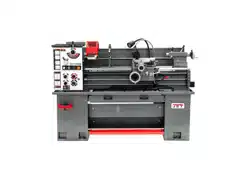Loading ...
Loading ...
Loading ...

9
5.2 Uncrating and cleanup
Machine is heavy. Use an
appropriate lifting device and use extreme
caution when moving the machine to its final
location. Failure to comply may cause serious
injury.
1. Finish removing wooden crate from around
lathe.
2. Unbolt lathe from shipping pallet.
3. Choose a location for the lathe that is dry, has
good lighting, and has enough room to be able
to service the lathe on all four sides.
4. Move carriage and tailstock to the tailstock end
of the bed.
5. Place two steel rods or pipes of sufficient
strength into four holes (A, Figure 5-2) of lathe
stand. Sling the lathe with properly rated
straps. Do not lift by spindle. With adequate
lifting equipment, slowly raise lathe off
shipping pallet. Make sure lathe is balanced
before moving to sturdy bench or optional
stand.
Figure 5-2
6. To avoid twisting the bed, the lathe's location
must be absolutely flat and level. Bolt lathe to
stand (if used). If using a bench, through-bolt
for best performance.
7. Clean all rust protected surfaces using a mild
commercial solvent, kerosene or diesel fuel.
Do not use paint thinner, gasoline, or lacquer
thinner, as these will damage painted
surfaces. Cover all cleaned surfaces with a
light film of Mobil DTE Oil Heavy Medium or
equivalent.
8. Remove end gear cover. Clean all
components of end gear assembly and coat all
gears with a heavy, non-slinging grease.
9. Using a machinist’s precision level on the
bedways, check to make sure lathe is level
side to side and front to back. If necessary,
loosen mounting bolts, shim, and retighten
mounting bolts. The lathe must be level to be
accurate.
5.3 Chuck preparation (three jaw)
Read and understand all
directions for chuck preparation. Failure to
comply may cause serious injury and/or
damage to the lathe.
Note: Before removing chuck from spindle, place
a way board across bedways under the chuck.
1. Support the chuck while turning three
camlocks 1/4 turn counter-clockwise with the
chuck key enclosed in the toolbox. Figure 5-3
shows the cam in the secure position. Line up
the two marks (A, Figure 5-3) for removal.
Figure 5-3
2. Carefully remove chuck from spindle and place
on an adequate work surface.
3. Inspect the camlock studs. Make sure they
have not become cracked or broken during
transit. Clean all parts thoroughly with solvent.
Also clean spindle and camlocks.
4. Cover all chuck jaws and scroll inside the
chuck with Mobilith AW2. Cover spindle, cam
locks, and chuck body with a light film of Mobil
DTE Oil Heavy Medium.
5. Lift chuck up to spindle nose and press onto
spindle. Tighten in place by turning cam locks
1/4 turn clockwise. The index mark (A, Figure
5-3) on the camlock should be between the
two indicator arrows (B, Figure 5-3). If the
index mark is not between the two arrows,
remove chuck and adjust the camlock studs by
either turning out one full turn (if cams will not
engage) or turning in one full turn (if cams turn
beyond indicator marks).
6. Install chuck and tighten in place.
ATTENTION: Only when the incised line on chuck
lines up with that on the spindle, can the chuck be
mounted.
Loading ...
Loading ...
Loading ...
